
Getting enough sleep is key to maintaining a healthy weight, preventing injury, and feeling better. The kind of sleep that protects health is of good quality and lasts for at least 7 uninterrupted hours. We know hardly anyone gets enough good sleep. Being overweight is associated with poor sleep quality and shorter sleep duration. Unfortunately, studies also show that hormonal fluctuations place women at risk for poor sleep quality.
Here’s why getting enough good sleep is fundamental to achieving weight loss. Hormones regulate your appetite, your body’s response to stress, and how well your body metabolizes the food you eat. When you do not sleep enough, your hormones change in a way that makes you gain weight because lack of sleep makes the following things happen:

1.You feel hungry.
2.Your body is stimulated to store fat.
3.You feel more stressed and less able to cope.
4.Your will power is reduced.
All of this adds up to mean you eat more calories when you don’t get enough sleep and your body puts those extra calories into fat storage.
Here’s the good news. When you get enough sleep, you are:
 more attentive,
more attentive,
 better able to organize, and
better able to organize, and
 more likely to sustain the will power required to make healthy changes.
more likely to sustain the will power required to make healthy changes.
There’s more good news—exercise improves sleep economy. That means women who run-walk get better quality sleep.
Tips for getting better sleep:
 Go to bed at the same time every night.
Go to bed at the same time every night.
 Get up at the same time every morning.
Get up at the same time every morning.
 Keep electronic devices out of the bedroom. This includes cell phones, computers, and televisions.
Keep electronic devices out of the bedroom. This includes cell phones, computers, and televisions.
 Don’t let pets sleep in your bedroom.
Don’t let pets sleep in your bedroom.
 Avoid drinking caffeine after 2:00PM. It’ll keep you awake!
Avoid drinking caffeine after 2:00PM. It’ll keep you awake!
 If you decide to drink alcohol, do so before 8:00PM. All forms of alcohol shorten the sleep cycle.
If you decide to drink alcohol, do so before 8:00PM. All forms of alcohol shorten the sleep cycle.
 Don’t smoke.
Don’t smoke.
 Avoid napping.
Avoid napping.
Forty percent of women experience sleep problems during menopause. But there’s good news! Rx Run-Walk will help improve the quality of sleep during menopause.
If you have been told you have a sleeping disorder like obstructive sleep apnea, make sure you use your CPAP machine every night.
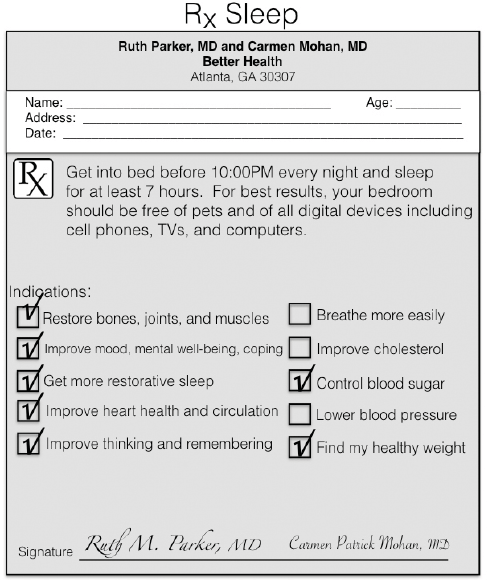
Regardless of which Rx Run-Walk prescription you are following, you should be taking 5,000 to 6,000 steps every day. You should be taking these steps IN ADDITION to doing your Rx Run-Walk. Studies have shown you need to do about 8,000 steps a day to maintain your weight and 10,000 to 12,000 steps a day for weight loss.
Before you start, try these suggestions:
 Create a space for meal planning in your calendar. At the beginning, you will typically need about an hour. Carmen usually does this on Sundays.
Create a space for meal planning in your calendar. At the beginning, you will typically need about an hour. Carmen usually does this on Sundays.
 Create a space in your calendar for grocery shopping.
Create a space in your calendar for grocery shopping.
 Have things you will need on hand: a reusable water bottle, reusable lunch box, and dishwasher-safe containers.
Have things you will need on hand: a reusable water bottle, reusable lunch box, and dishwasher-safe containers.
 Prepare your household for the new food coming their way. Request their support in improving everyone’s health, not just yours.
Prepare your household for the new food coming their way. Request their support in improving everyone’s health, not just yours.
Following your Rx Eat prescription requires strategic planning on a weekly basis. Here’s how to organize your life so you stick to your Rx Eat. Plan your food and eat only what you planned.
Look at your work and life schedule. Decide which days you will cook and eat at home and which days you will eat out. Attack the hardest question first—what’s for dinner? Plan leftovers, pick-up, or delivery for evenings when your household is busiest.
Generally, Carmen finds the following pattern for a week of dinner planning works well for her busy household of four: two fish meals, one poultry meal, two vegetarian meals, and two meals of leftovers or eating out. She then traces her footsteps back to see if any leftover dinner items can be reused in lunches for the week.
Her lunch patterns include: two lunches from leftovers, one pre-made/store-bought lunch (e.g., sushi), three sandwiches, and one surprise or new food.
Her breakfast patterns include: one or two make-ahead items (e.g., muffins, yogurt parfaits, breakfast burritos, hard-boiled eggs), two pre-made breakfasts (e.g., cereal and nuts), and three easy-to-make-in-real-time breakfasts (e.g., toast with nut butter).
Write down all of the meals you will eat for the week, including breakfasts, lunches, and snacks. Flip through a recipe book or magazine (Ruth likes Cooking Light) looking for meals that appeal to you. Write down the page number next to the meal on your plan for easy reference when you are cooking. Also note where a make-ahead item lies (e.g., pizza dough, marinade sauce, frozen banana, roasted beet, hard-boiled eggs).
As you are planning, use the food score to help you plug holes. For example, go ahead and tally up each day to create a food score. If you are missing a particular food category, review the list to see if there is an easy way to include that category to boost your score for the day. See the table below for ideas. Post the meal plan for the week on the fridge so everyone in your household knows what to expect that week.
It will probably take between 2 to 3 months to develop your go-to meals—meals you discover you enjoy and also are in keeping with your Rx Eat. Save your weekly meal plans so you can recycle the best ones. Carmen has found that doing this consistently over the course of a year allows her to reuse her best meal plans to eat seasonally and locally.
Download the following sheet for convenient use.
For the week of: |
Dinner |
Breakfast |
Monday |
M: |
|
Tu: |
|
W: |
|
Th: |
Tuesday |
F: |
|
Sat: |
|
Sun: |
|
Lunch |
Wednesday |
M: |
|
Tu: |
|
W: |
|
Th: |
Thursday |
F: |
|
Sat: |
|
Sun: |
|
Snacks |
Friday |
M: |
|
Tu: |
|
|
|
W: |
Saturday |
Th: |
|
|
|
F: |
|
|
Sunday |
Sat: |
|
Sun: |
|
|
Go to the grocery store and only buy food on the list. Use this grocery store overview to plan how you shop:
•It’s hard to go wrong in the areas where you find frozen fruits and veggies, fresh fruits and veggies, and nuts. Incorporating fruits and vegetables will be easiest in these zones.
•In the zones that contain dairy, protein, wine, beans, rice, grains, and good fat are where you need to visit to buy items which should be on your list, but you’ll have to be looking for particular items to avoid excess sugar, bad fat, and processed foods. You’ll have to be careful with the way you choose (don’t fall into the red meat trap or buy unhealthy packaged frozen dinners). You’ll only need a few items from these zones.
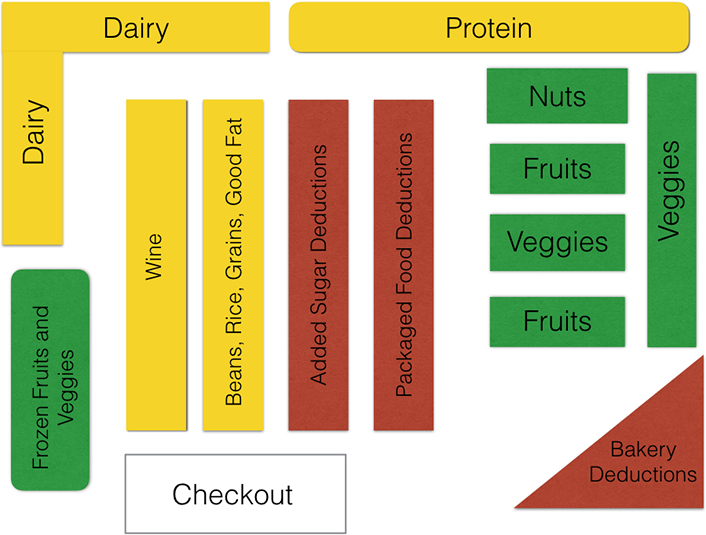
•Finally, the remaining zones are where only deductions lurk. It’s easy to buy packaged processed foods that should not be included in your diet. Spend very little time in the these zones if you go down those aisles at all. Generally, you should spend the bulk of your shopping time in the aisles that are closest to the walls of the grocery store.
Decide when you’ll prepare dinner and pack lunches. This is one of the hardest steps because it does take time. Here’s another fundamental truth—eating right takes time. At first, cooking and eating differently will require more attention and concentration, but over time, you’ll become a pro.
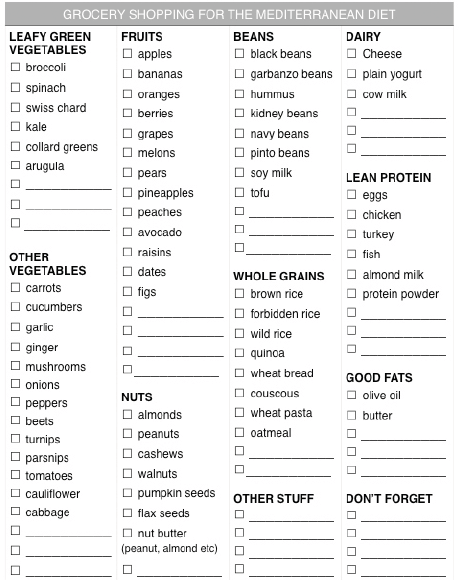
Half of your plate should be non-starchy vegetables, one quarter of it should be protein, and one quarter of it should be healthy grains. Eat meals with others. Enjoy the company. Ban electronics—especially cell phones—at meals. Households that eat together, stay together!
More Tips for Weight Loss and Healthy Eating:
1.Drink 8 ounces of water about 5 minutes before you eat.
2.Drink 4 cups of unsweetened tea daily (green tea is better than black).
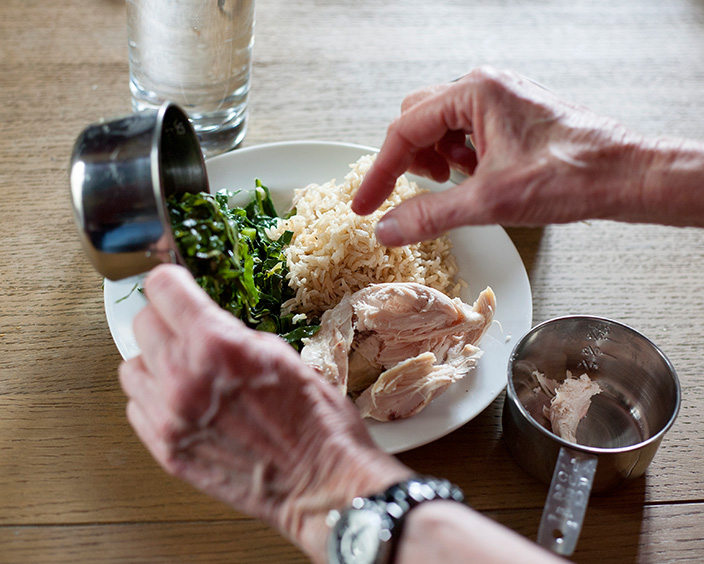
3.Avoid getting hungry. Snack on as many fresh fruits and vegetables as you need to feel good.
4.When you eat out, ask for a to-go container when you order food. Place half of the portion in the container BEFORE you begin eating.
5.When you travel, take a snack with you. An apple and a handful of nuts are easy to carry in your purse. When you arrive at your destination, go grocery shopping as soon as you can even if you’re only away from home for a day or two.
Snacks to Always Have Ready
•Hard-boiled eggs
•Hummus
•Fresh fruits and nuts
•Fresh veggies chopped into sticks
•Popcorn

Ways to Score the Veggie Point in the Food Score
•Add a leafy green vegetable to breakfast in an omelette or smoothie. You’ve already gotten the most important tally mark and the day has just begun!
•Have veggies as part of your snack every day.
•In salads, combine veggies with fruit like citrus, avocado, or berries to make them tasty. Adding cheese crumbles, left over rotisserie chicken pieces, or 1/4 cup of nuts is also a way to make salads more filling.
Here’s a recipe for salad dressing that is in keeping with the Mediterranean diet:
In a small bowl, mix together the following ingredients:
•Juice from 1/2 lemon (Fruit +1)
•1Tbsp olive oil (Good fat +1)
•1/8 teaspoon salt
•Sprinkling of pepper to taste
•2 Tbsp fresh parsley or 1 teaspoon dried basil (Veggie +0.5)
Toss with your favorite veggies for good flavor.
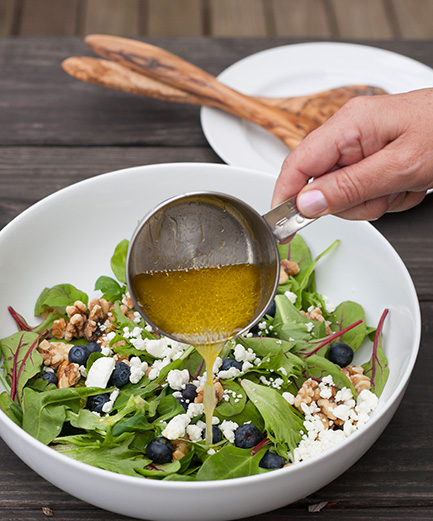
•Some women find they don’t like eating green leafy veggies because they are bitter. Try removing some of the bitterness of vegetables (like kale and asparagus) by blanching them. Blanching is a cooking technique where you boil water, then place the cut vegetable into it for one minute and remove. Stop the cooking process by steeping the veggies in ice cold water for another minute.
If the foods are new to your household, they can take some time to become popular. Some studies show that a new vegetable has to be given to children about 15 times before they will be happy eating it. For young children, we recommend the “You don’t have to eat it, you only have to try it” approach. Make a deal that eating one spoonful of each new food on the plate is part of a tradition at your table. Say, “Just eat what you like and leave the rest. You don’t have to like everything.” At the same time, do NOT provide an alternative meal. Adopt this frame of mind: You have taken the time to prepare a nutritious, healthy meal which your family should enjoy as a way to honor you. One household, one meal may seem rigid, but it’s one way to lead everyone to healthy living. As they say in Germany “Der Hunger ist der beste Koch” (Hunger is the best cook).

•Special occasions should be just that—special. These should be one or two days per year, not every other week. Nowadays it seems like every time we turn around, the day is special. Friends’ birthdays, children’s birthday parties, weddings, Halloween, Valentine’s Day, and the winter holidays are just the tip of the iceberg of sugary temptations that make for nothing but food score deductions (and weight gain).
•On the other hand, trying to lose weight during the holidays is not a realistic goal. Doing so makes for misery. Instead of trying to lose weight, your goal should be to enjoy your friends and family without gaining weight. It is okay to sample treats. After the holidays, go back to your plan. Remember, the holidays are only one or two days per year. Decide which days are truly special for you this year. Enjoy those days and then quickly get back to your prescribed food routine.
•Trying to lose weight can be frustrating and slow going. If it were easy, we wouldn’t have written this book.
•Weight loss comes from following your Rx Eat and combining it with your Rx Run-Walk. You will not lose weight if you don’t follow both!
•Regardless of whether or not you lose weight, you will gain health with your Rx Run-Walk and Rx Eat.
•In both the Get Started and Keep Going prescriptions, you lose weight from eating good foods in the right amounts while you build your body up to doing more physical activity (and faster weight loss). Make sure you’ve given your body enough time to adjust (12 weeks) to the Rx Keep Going and Rx Eat. Then, proceed to Rx Run-Walk: Burn Fat and its corresponding Rx Eat prescription.
•Are you getting enough sleep? Remember that sleep is absolutely critical for weight loss. If you are not regularly getting 7 hours of good sleep, your body is working against you in the quest for weight loss.
•Are you at the full dose (week 30) in your Rx Run-Walk? If so, have you been at the full dose for at least 12 weeks? A minimum of 150 minutes of run-walk weekly is required to maintain weight.
•You will have to run-walk more than 150 minutes per week if you want to lose weight through exercise. When you are ready, start the Rx Run-Walk: Burn Fat training program and combine it with the Rx Eat: Burn Fat prescription.
•Your Rx Eat requires eating the Mediterranean diet by measuring all food in cups. You should be writing it all down so you have an accurate record of what you are doing. Only after about one month should you lose between 2 and 4 pounds. Are you sure you are recording absolutely everything you eat and drink?
•Review your journal. Where are you receiving deductions? You may need a higher food score to achieve weight loss. Try for scores of 7 or 8. This will mean removing all foods and drinks that lead to deductions.
•If after a month of near-perfect food scores you still haven’t seen the scale tip, try eating less frequently. Remove one snack.
•If none of the above solutions works for you, try going old school and start counting calories. Look to see where you are going over the recommended 1600 kcal diet per day. Consider using a smart phone application to count calories like FitDay or MyFitnessPal.
•Show your journal to your doctor and share your concerns. Follow your doctor’s advice.
Download the following sheet for convenient use.
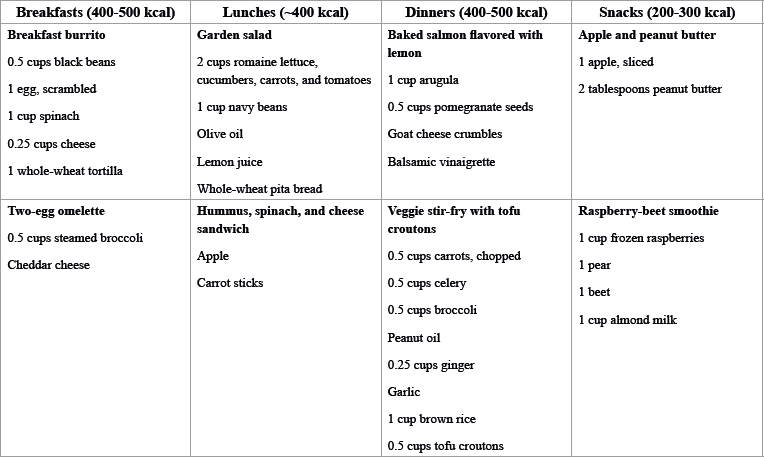
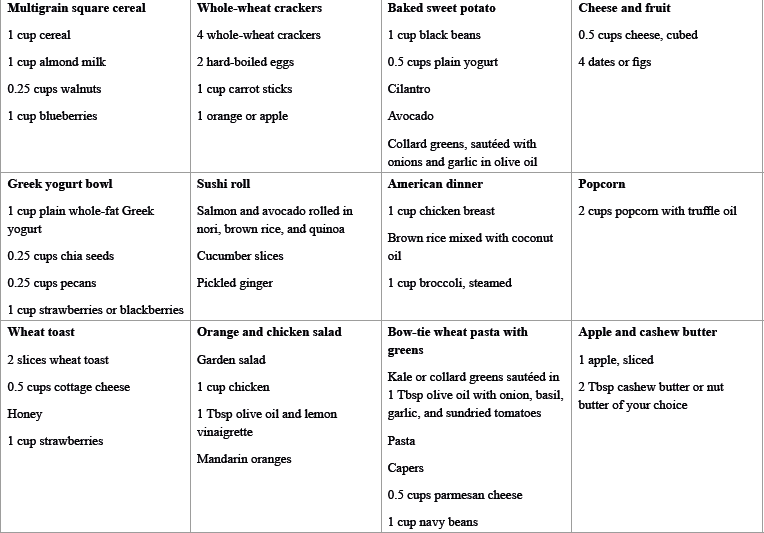
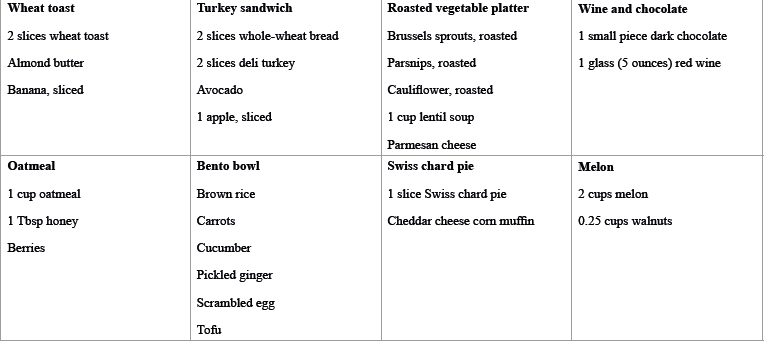
Throw the ingredients into a blender!
Chocolate, Banana, and Spinach Smoothie
•1/3 cup whey protein powder, chocolate flavor (+1 protein)
•1 frozen banana (+1 fruit)
•1 cup spinach leaves (+1 veggie)
•1 cup almond milk (+1 nut)
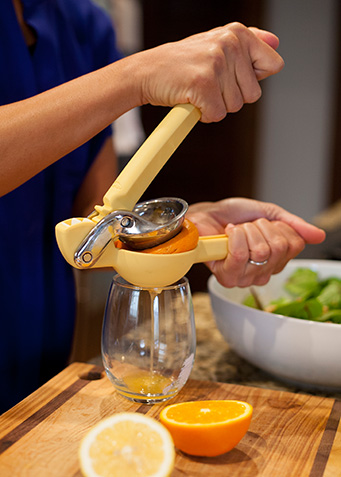
Berry Pink Smoothie
•1 roasted beet, skin removed (+1 veggie)
•1 pear, cored (+1 fruit)
•1 cup frozen raspberries (+1 fruit)
•1 cup almond milk (+1 nut)
•1/3 cup whey protein powder, vanilla flavor (optional, +1 protein)

Kale and Coconut Smoothie
•1 cup coconut water
•2 kale leaves, stems removed (+1 veggie)
•1/2 cup plain yogurt (+1/2 dairy)
•1 tablespoon almond butter (+1 nuts)
•1 tablespoon honey
•1 cup ice
Lettuce Drink Smoothie
•2 leaves romaine lettuce (+1 veggie)
•1 cup grapes (+1 fruit)
•1 apple, cored (+1 fruit)
•1 cup ice
•1 cup water
Pineapple and Coconut Smoothie
•8 ounces canned pineapple in juice (unsweetened, +1 fruit)
•1/4 cup coconut milk (+1 nut)
•1 cup spinach (+1 veggie)
•1 cup protein powder, vanilla flavor (optional, +1 protein)
Cooking Light magazine